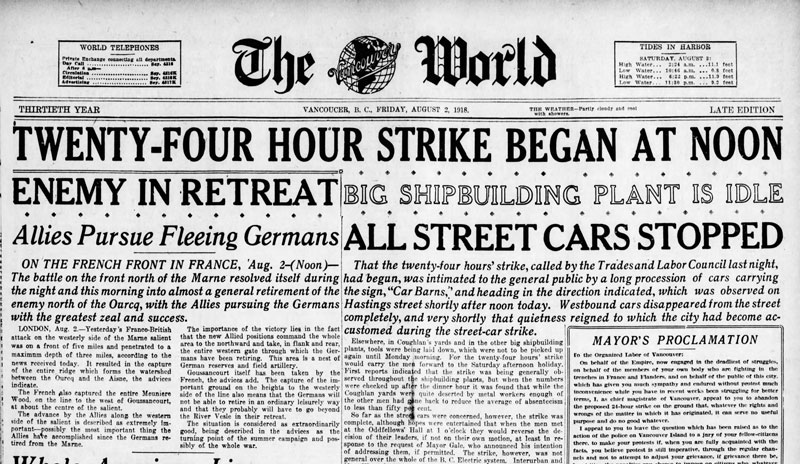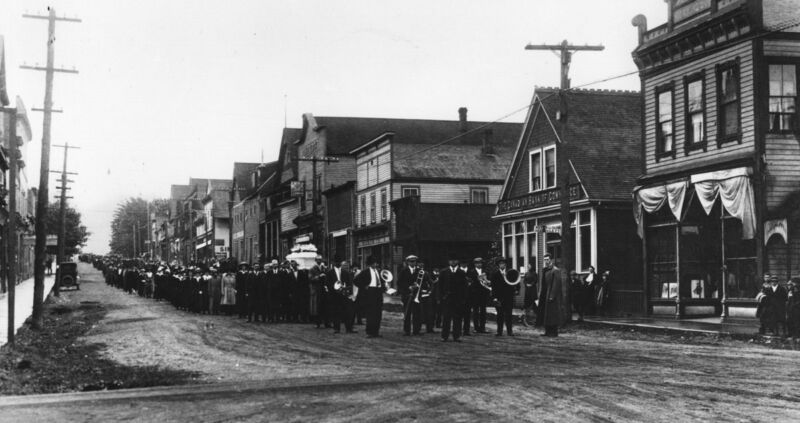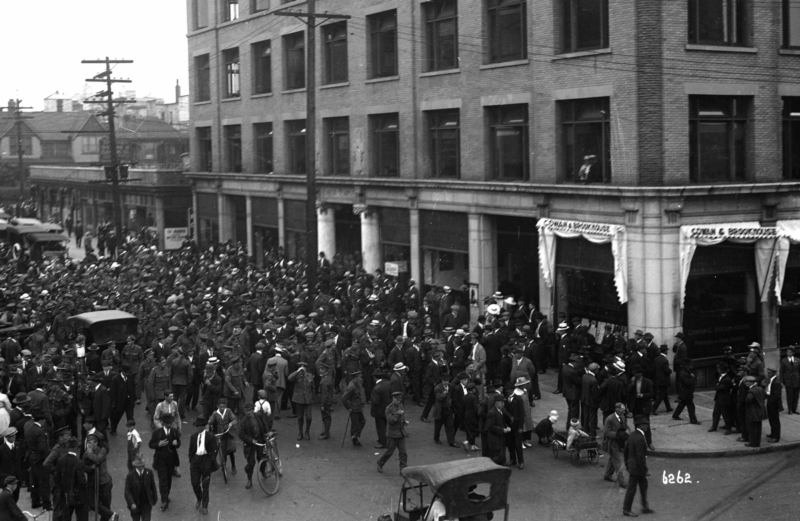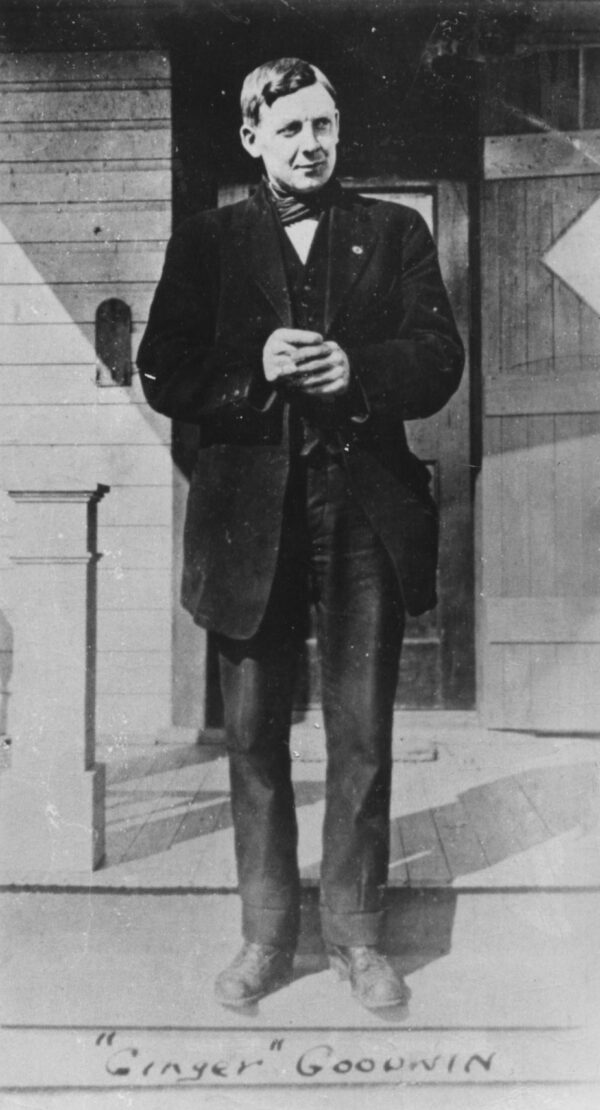The Ginger Goodwin General Strike
Published: August 7, 2018
Authors: Rod Mickleburgh
At 12 o’clock sharp on August 2, 1918, Vancouver transit operators stopped their streetcars in mid-route, drove them to the barns and walked home. The city’s normally bustling waterfront fell silent, as 2,000 burly stevedores and shipyard workers streamed from the docks. Construction workers refused to pound another nail or lift another brick. They joined textile and other union workers across Vancouver who were also leaving their jobs. It was the start of Canada’s first general strike and the beginning of one of the most memorable 24 hours in the city’s history.

With justification, they argued it was a pointless conflict that sent ordinary workers to kill each other, while politicians and leading citizens far from the fray thundered about patriotism, and the rich got richer on the profits of war. Goodwin had had his status suspiciously changed from “unfit to serve” to “fit”, after leading a strike for an eight-hour day at the large smelter in Trail. He was felled by a single shot from Dan Campbell, a special constable with a dubious background, who claimed he fired in self-defense. But the coal miners of Cumberland and the BC labour movement believed it was cold-blooded murder, and their rage was palpable. Campbell, later charged and acquitted of manslaughter, beat a hasty exit out of town to save his skin. Goodwin’s funeral procession was as large an event as the gritty, working-class community ever had.

Ginger Goodwin’s funeral procession. Cumberland Museum & Archives, C110-001.
Headed by a brass band, the line of mourners accompanying Goodwin’s white casket to the cemetery stretched as far as the eye could see. Years ago, I interviewed a sprightly, life-long resident of Cumberland who remembered witnessing the poignant procession as a little girl. She recalled how much Ginger Goodwin, who spent several years in the mines of Cumberland, was admired by locals, for his fierceness in standing up for the miners’ cause during their epic two year strike from 1912-1914 and his prowess on the village soccer squad. “My father would never hear a bad word about Ginger,” she told me.
When news of Goodwin’s shooting reached Vancouver, leaders of the Vancouver Trades and Labour Council responded with a call for a 24-hour general strike on the day of his funeral. “The time for talking was past,” said council secretary Victor Midgley, as the directives went out. “Workers should use the only means of protest they had, namely to quit work for the entire time stated.” Added labour firebrand Jack Kavanagh: “Whether shot in self-defence or without a chance, it does not alter the fact that he was of ourselves and the least we can do is stop work for twenty-four hours to punish the employers.”
The strike set off a firestorm among the city’s elite and a large group of returned war veterans who were whipped into a frenzy, some suggest by the Board of Trade and Canadian Manufacturers’ Association. Accused of being both “Bolshevki” and pro-German, the strikers were hysterically denounced for shutting down the city in support of someone dodging the draft, while Canadians were dying at the front. Fulminated MP Herbert Sylvester Clemens: “If organized labour is to ally itself with draft evaders and lawbreakers, all right-thinking elements in the community will have to take steps to fight their danger.”
It didn’t take long. That afternoon, a mob of several hundred ex-soldiers gathered outside the Labor Temple, which still stands at the northeast corner of Dunsmuir and Homer, its old lettering clearly visible over the entrance. After a few inflammatory “calls to arms”, they stormed through the doors and began ransacking Council premises. Books, documents, correspondence and other files were tossed out the window. Tables and chairs were trashed. On the second floor, they crashed through an office door to rush towards Council secretary Victor Midgley, who crawled out on the window ledge to escape their fury. As they jostled to get at him, their way was blocked by courageous Frances Foxcroft of the Telephone Workers Union, who would not be moved.

A mob gathered outside the Vancouver Labor Temple, Vancouver Public Library 18624
Eventually, the shaken labour leader was allowed back in and roughly bustled downstairs to face the raucous crowd outside. By this time the crowd with mayhem on its mind numbered more than a thousand. “That is the man that is at the bottom of all the troubles,” yelled a soldier. “Make the skunk kiss the good old flag,” jeered the throng. Midgley’s glasses were knocked off, his collar torn, until his lips finally touched the sacred Union Jack, his offer to address the veterans ignored, and police were able to bundle him back inside the Labor Temple. Several other labour representatives escaped by clambering down the fire escape and dashing down the back alley. Longshore union delegate J. Thomas was not so lucky. He found himself caught in the middle of the crowd, where he was severely set upon until he, too, reluctantly agreed to kiss the flag. When police attempted to haul him away to the station, soldiers surrounded their car in an unsuccessful effort to grab Thomas back, with shouts of “Let’s take him ourselves!”
Then, it was off to the car barns to intimidate trolley drivers into resuming service, which actually happened shortly before midnight, and finally to a packed, rowdy public meeting of self-proclaimed patriots, where speaker after speaker were cheered for lashing out at Goodwin and local strike leaders. “They are just as bad as the man who got shot in the front or the back – I hope both” shouted one inflamed citizen, to a thunderous ovation. It was a common sentiment. The lone attendee to vote against a resolution calling for them to be forced into military service overseas was physically ejected.
The next morning, with the waterfront still silent, the fired-up war veterans, still exulting over their “triumphs” of the previous day, decided to take on the longshoremen and force them back to work. It was not to be. This time, when they tried to assail the union hall ramparts at Pender and Hornby, they got a surprise. “Charging up a long set of stairs, they were met by longshoremen who beat them back using chair legs as staves,” wrote historian Irene Howard. A tense standoff ensued, until Mayor Robert Henry Otley Gale arrived. He convinced the agitated veterans to appoint a committee to talk to a longshoremen committee, ignoring their demand that the Labour Council’s Jack Kavanagh be ordered out of the city.
The upshot was that the rioters marched off to the Cambie Street grounds, the dockyard workers returned to their jobs at a time of their choosing, and leaders of the Trades and Labour Council agreed to test the persistent accusation that the rank-and-file did not support the general strike by resigning and calling new elections. All but one or two were handily re-elected. By Monday morning, everyone was back at work, except for 50 shoe factory workers whose employer demanded they apologize for their Friday walkout before he would allow them back in.
In the face of fierce intimidation, pro-war hysteria and mob violence, the remarkable success of the first general strike of its kind signified the increasing radicalism of the BC trade union movement, particularly in Vancouver. Less than a year later, the city’s unions walked out again, this time for an entire month, in a sympathy strike to back the 1919 Winnipeg General Strike. The horrors of World War One and the failure of rampant capitalism to deliver any kind of economic justice to those who did the work led more and more unions to embrace socialism as the only alternative to a broken system.
Ginger Goodwin would have understood.

Cumberland Museum and Archives, C110-002